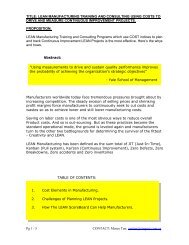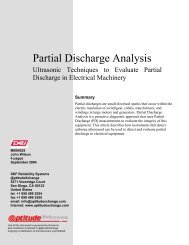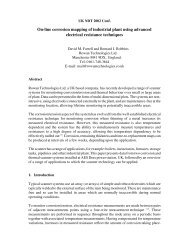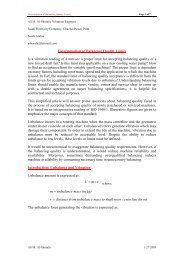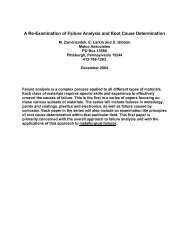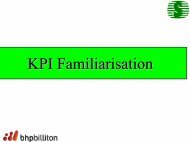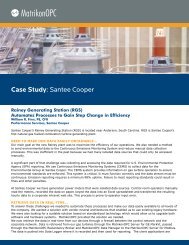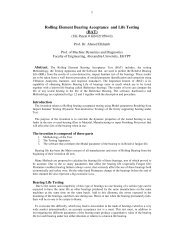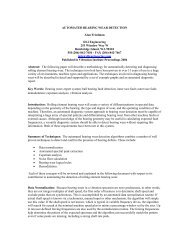Developing an Asset Management Strategy - Plant Maintenance ...
Developing an Asset Management Strategy - Plant Maintenance ...
Developing an Asset Management Strategy - Plant Maintenance ...
You also want an ePaper? Increase the reach of your titles
YUMPU automatically turns print PDFs into web optimized ePapers that Google loves.
• Reward systems. Each pl<strong>an</strong>t rewards<br />
behavior in subtle ways. It may promote the<br />
overbearing craftsm<strong>an</strong> to a supervisor position<br />
because “he gets people going”. We may<br />
reward equipment breakdown with money<br />
<strong>an</strong>d admiration (overtime <strong>an</strong>d “attaboys”).<br />
We may reward production achievement at<br />
<strong>an</strong>y cost to people <strong>an</strong>d asset condition. We<br />
reap what we sow, so we must be careful that<br />
our reward systems actually encourage<br />
proactive behavior. Proactive mainten<strong>an</strong>ce<br />
c<strong>an</strong>’t happen in a reactive m<strong>an</strong>aging<br />
environment.<br />
• Roles, responsibilities <strong>an</strong>d accountabilities are<br />
clear. If job expectations are not clear <strong>an</strong>d<br />
results measurable, we have muddled<br />
accountability. Fingers point in all directions,<br />
<strong>an</strong>d the blame game goes on all day. Being<br />
proactive in such a system takes more courage<br />
th<strong>an</strong> most people will risk. Clarifying jobs <strong>an</strong>d<br />
accountabilities is a leadership function.<br />
• Feedback. This is part of the Pl<strong>an</strong>-Do-<br />
Review process, but gets special emphasis.<br />
We shape behavior by giving honest feedback<br />
without punishment. Under the right<br />
circumst<strong>an</strong>ces people w<strong>an</strong>t to improve.<br />
Leadership fails if it doesn’t capture that spirit.<br />
Strategic Pl<strong>an</strong>ning. In every pl<strong>an</strong>t environment we<br />
encounter we hear the same (legitimate) complaints:<br />
“Improving mainten<strong>an</strong>ce is import<strong>an</strong>t, but we just<br />
don’t have time. We have 4 major pl<strong>an</strong>t initiatives <strong>an</strong>d<br />
5 corporate initiatives, <strong>an</strong>d don’t know how <strong>an</strong>y of<br />
them are going to get done!” Or, “Everything we do is<br />
a ‘flavor of the month’. We seem to start lots of stuff,<br />
but never finish”.<br />
How do you set a pl<strong>an</strong> that is timeless One that has<br />
approvals all the way to the top of the comp<strong>an</strong>y<br />
How do you assure you have a single initiative instead<br />
of 20 Through the act of strategic pl<strong>an</strong>ning!<br />
The product of functional strategic pl<strong>an</strong>ning is<br />
alignment around a multi-year improvement pl<strong>an</strong>.<br />
To get alignment requires more th<strong>an</strong> a few words in a<br />
book. It requires that every level of the org<strong>an</strong>ization<br />
believes the content of the pl<strong>an</strong> is the most import<strong>an</strong>t<br />
The Future Of <strong>Asset</strong> M<strong>an</strong>agement<br />
set of things the comp<strong>an</strong>y c<strong>an</strong> do with its resources.<br />
That me<strong>an</strong>s a real <strong>an</strong>d compelling business case for the<br />
senior executives. For pl<strong>an</strong>t executives it me<strong>an</strong>s<br />
working on those things which are most practical,<br />
which make a difference in daily control of the work<br />
<strong>an</strong>d reduction of vari<strong>an</strong>ce. For the staff functions it<br />
me<strong>an</strong>s <strong>an</strong> underst<strong>an</strong>ding of the support they must<br />
render to enable the pl<strong>an</strong> to be successful.<br />
The elements of the Strategic Pl<strong>an</strong> are these:<br />
1. Benchmarking the function. Where are we<br />
today What are the measures saying<br />
2. <strong>Developing</strong> a vision for the future of pl<strong>an</strong>t<br />
operations. Difficult to do, sometimes requires<br />
“Industrial tourism” to see the bigger picture,<br />
<strong>an</strong>d using outside help to underst<strong>an</strong>d what’s<br />
possible. This part has to be done right, or the<br />
pl<strong>an</strong> will fall apart. Our clients have found the<br />
Execution Tri<strong>an</strong>gles (Production, Logistics <strong>an</strong>d<br />
<strong>Asset</strong> Healthcare) to be valuable to setting the<br />
vision. See Figure 3.<br />
3. Identify Gaps. Where do we fall short of the<br />
vision<br />
4. Identify Strategies to close gaps. It would be<br />
easy to shortcut this task. But one may find<br />
that, for inst<strong>an</strong>ce, a distributed control system<br />
may be a strategy that helps with product<br />
quality, product mix direction, faster<br />
ch<strong>an</strong>geovers, <strong>an</strong>d equipment condition<br />
monitoring. So one strategy covers several<br />
gaps.<br />
5. Describe Projects to implement strategies.<br />
This c<strong>an</strong> get creative, <strong>an</strong>d will be <strong>an</strong> integrating<br />
force. For inst<strong>an</strong>ce, a pl<strong>an</strong>ning <strong>an</strong>d scheduling<br />
project may be combined with a safety<br />
improvement initiative. Preventive<br />
mainten<strong>an</strong>ce improvement may combine with<br />
<strong>an</strong> ISO calibration st<strong>an</strong>dard.<br />
6. Develop the implementation pl<strong>an</strong>. It will<br />
require resources, so don’t shortcut or lowball<br />
what the implementation will require.<br />
Remember that training won’t create new<br />
behaviors. People need to be coached for<br />
new behaviors, <strong>an</strong>d measures put in place to<br />
determine success.<br />
Copyright 2003 by Strategic <strong>Asset</strong> M<strong>an</strong>agement Inc. 3



